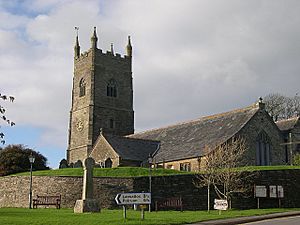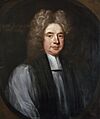Charles Trelawny facts for kids
Quick facts for kids
Charles Trelawny
|
|
|---|---|
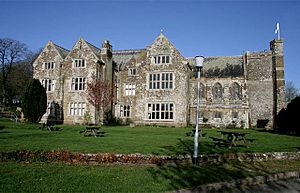
Family home, Trelawne Manor
|
|
| Member of Parliament for Plymouth |
|
| In office 1698–1713 |
|
| Vice-Admiral of South Cornwall | |
| In office 1702–1710 |
|
| Governor of Plymouth | |
| In office 1696–1720 |
|
| Member of Parliament for East Looe |
|
| In office 1689–1698 |
|
| Governor of Dublin | |
| In office 1690–1690 |
|
| Personal details | |
| Born |
Charles Trelawny
1653 Trelawny House, Pelynt |
| Died | 24 September 1731 (aged 78) Hengar, Cornwall |
| Resting place | St Nonna, near Pelynt |
| Nationality | English |
| Political party | Tory |
| Spouses | (1) Anne Morice 1690 (2) Elizabeth Mitchell |
| Relations | Sir Edward Seymour 1632-1708 (Uncle) Sir Jonathan Trelawny 1650-1721 (Brother) |
| Occupation | Soldier and politician |
| Military service | |
| Allegiance | |
| Branch/service | Army |
| Years of service | 1673-1692 |
| Rank | Major General 1690 |
| Unit | Colonel, 4th Foot 1682-1692 |
| Battles/wars | Franco-Dutch War Maastricht; Enzheim; Altenheim Tangier Garrison 1680-1684 Monmouth Rebellion Sedgemoor Williamite War in Ireland The Boyne; Cork |
Major General Charles Trelawny (1653 – 24 September 1731) was an English soldier and politician from Cornwall. He played an important part in the Glorious Revolution of 1688. He also served as a Member of Parliament (MP) for different areas between 1685 and 1713.
Trelawny started his military career in 1673. He held several high-ranking positions under Charles II of England. Like many Tories, he first supported James II of England becoming king in 1685, even though James was Catholic. However, Trelawny later changed his support in 1688. This showed how much James had upset his main supporters.
His older brother, Sir Jonathan Trelawny, was one of the Seven Bishops. These bishops were put on trial but found innocent. This event greatly weakened King James's power. Charles Trelawny, along with John Churchill, helped gather support in the army for the Glorious Revolution in November 1688. During this time, James was replaced by his Protestant daughter Mary and her husband, William of Orange.
Trelawny fought in the Williamite War in Ireland from 1689 to 1691. He then left the army in 1692. He continued to be an MP and helped manage politics in Cornwall and Devon. He worked for Sidney Godolphin, who was a very important government official called the Lord High Treasurer from 1702 to 1710. Trelawny supported George I becoming king. He left Parliament in 1713 and lived a quiet life at home until he died in 1731.
Contents
About Charles Trelawny
Charles Trelawny was born in 1653. He was the fourth of five sons born to Sir Jonathan Trelawny (1623-1681) and Mary Seymour (1619-1680). His mother was related to the powerful Dukes of Somerset family. His brothers included Jonathan (1650-1721) and Henry (1658-1702).
On May 1, 1690, Trelawny married his cousin, Anne Morice (1672-1690). She was the widow of William Morice, an MP for Newport in Cornwall. Sadly, Anne died in childbirth in 1690. Trelawny then inherited her land near Hengar, Cornwall. In June 1699, he married again to Elizabeth Mitchell. Her father, Thomas, was a church leader in Gloucestershire. They had one daughter who survived, but not much is known about her. It seems she died before her father, as Trelawny left his land and property to his nephew Edward.
His Military and Political Life
Early Military Career: 1673-1684
After a period of civil wars in England and Scotland, many people did not like the idea of a large professional army. So, if someone wanted to be a soldier, they often joined armies in other countries. In 1670, King Charles II of England secretly agreed to help France attack the Dutch Republic. He promised to send 6,000 British soldiers to join the French army.
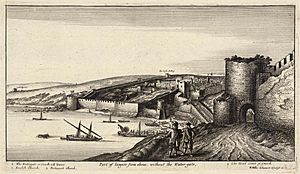
When the Franco-Dutch War started in 1672, Trelawny joined the Royal English Regiment. This group was part of the British soldiers sent to France. The alliance with Catholic France was not popular in England. Many people did not trust it, especially against the Protestant Dutch. So, this British group mostly fought in the Rhineland area. However, some officers, including Trelawny and John Churchill, volunteered to fight in the 1673 siege of Maastricht.
The war between England and the Dutch ended in 1674. But the larger Franco-Dutch War continued until 1678. In March 1674, Trelawny became a captain. From 1674 to 1675, his unit fought in battles like Enzheim and Altenheim. The number of soldiers in the British group decreased, and people at home opposed the war. So, the group was officially ended in 1676.
In July 1680, Trelawny was made a major in the 2nd Tangier Regiment. This regiment was formed to serve in the Tangier Garrison. Tangier was an English possession since 1662. The soldiers there suffered many losses from sickness and fighting. Trelawny's oldest brother, John, was killed there in May 1680. Trelawny took command of the regiment in 1682 and stayed in Tangier until England gave up the territory in 1684.
The Glorious Revolution: 1685-1688
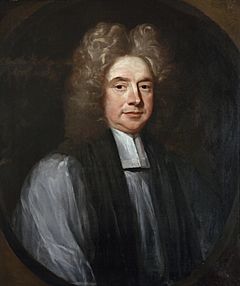
When James became king in 1685, Trelawny supported him, like most Tories. Trelawny's family was powerful and well-connected. This included his brother, Sir Jonathan, who was then the Bishop of Bristol. His uncle, Sir Edward Seymour, was also an important figure. This family influence helped keep the West Country stable during the Monmouth Rebellion. Trelawny fought in the Battle of Sedgemoor in July 1685.
In the 1685 election, Trelawny became an MP for East Looe. This area was controlled by his family. In November, King James stopped Parliament from meeting because they would not pass his new laws.
Over the next two years, James tried to make sure Parliament would vote his way. This upset the traditional power of the wealthy landowners, both Tories and Whigs. The army grew much larger, from 9,000 to 34,000 soldiers. James, being Catholic, believed his fellow Catholics would be more loyal. So, he used his royal power to ignore the 1673 Test Act. This act prevented Catholics from holding important public jobs. He appointed Catholics to high positions. A group called the Association of Protestant Officers was formed to resist this. Trelawny, Marlborough, and Kirke were members of this group.
Concerns about religious policy grew in May 1688. The Seven Bishops were put on trial for speaking out against the king. One of them was Trelawny's brother, Sir Jonathan Trelawny. Many people were willing to accept James as king for a short time because his Protestant daughter Mary was next in line for the throne. However, when James's son, James Francis, was born on June 10, 1688, it meant there could be a line of Catholic kings.
The bishops were found innocent on June 30. This led to many anti-Catholic riots across England and Scotland. On the same day, an invitation was sent to Mary's husband, William of Orange. It "invited" him to take the throne for his wife. This invitation was signed by seven important people, including Tories, Whigs, church leaders, and navy officials.
Trelawny and other officers joined William as he moved forward. Many soldiers left the Royal army, reducing it from 34,000 to less than 4,000. James went into exile on December 23. This event is known as the Glorious Revolution because it changed the king without much fighting.
Later Years: Ireland and England; 1689-1731
King James had briefly removed Trelawny from his regiment. But William restored him, and Trelawny spent the next two years fighting in the Williamite War in Ireland. He was promoted to Brigadier-general in March 1689. He led a group of soldiers at the Battle of the Boyne in July. He then served in Marlborough's military campaign. He was briefly Governor of Dublin before helping Marlborough capture Cork in September 1690.
Trelawny was promoted to major-general on December 2, 1690. He returned to England when the war ended in October 1691. In January 1692, he resigned as colonel, and his brother Henry took his place. People have suggested different reasons for his resignation. One reason might be his friendship with Marlborough, who was also removed from his military and political jobs around the same time. Another idea was that his wife had died in childbirth, and he wanted to "live quietly in the country."
In 1694, Trelawny was suggested to lead the Coldstream Guards. But the Whigs, who were powerful in Parliament, insisted that John Cutts get the position instead. In politics, family connections were often as important as political ideas. The 'Whig' Granvilles and the 'Tory' Seymours competed for power in Devon and Cornwall.
After the Tories gained more power in the 1695 election, Trelawny replaced John Granville as Governor of Plymouth. He also became an MP for Plymouth in 1698, a position he held until he retired in 1713.
In 1701, his brother Henry Trelawny also became an MP for Plymouth. When Henry died in 1702, another Tory replaced him. Charles Trelawny helped manage politics in the West Country for his friend, Sidney Godolphin. Godolphin was the Lord High Treasurer from 1702 to 1710. In 1702, Trelawny was given the mostly honorary title of Vice-Admiral of South Cornwall. In 1706, his older brother became Bishop of Winchester, which was one of the richest and most important church positions in England.
Trelawny supported George I becoming king in 1714. He stepped down as an MP in 1713 but continued as Governor of Plymouth. Plymouth was a very important town and military base. He kept this job even under King George I, who was very against the Tories. This showed how reliable Trelawny was. He left the governor position in 1720 and lived quietly at Hengar. He died at home on September 24, 1731. He was buried in the church of St Nonna, near Pelynt, next to other family members. He left his land and property to his nephew Edward.
Images for kids
-
Tangier around 1670. Trelawny served here from 1680 to 1684.
-
Charles' older brother, Sir Jonathan Trelawny, was one of the Seven Bishops found innocent in 1688.
| Parliament of England (to 1707) | ||
|---|---|---|
| Preceded by Sir Jonathan Trelawny, Bt John Kendall |
Member of Parliament for East Looe 1685–1687 |
Succeeded by Henry Trelawny Sir Henry Seymour, Bt |
| Preceded by John Granville George Parker |
Member of Parliament for Plymouth 1698–1707 |
Succeeded by Parliament of Great Britain |
| Parliament of Great Britain (1707–1800) | ||
| Preceded by Parliament of England |
Member of Parliament for Plymouth 1707–1713 |
Succeeded by Sir George Byng Sir John Rogers, 2nd Bt |
| Military offices
|
||
| Preceded by Percy Kirke |
Colonel 4th Foot 1682–1688 |
Succeeded by Sir Charles Orby, Bt |
| Preceded by Sir Charles Orby |
Colonel, 4th Foot 1688–1692 |
Succeeded by Henry Trelawny |
| Preceded by The Earl of Bath |
Governor of Plymouth 1696–1722 |
Succeeded by Charles Churchill |
| Honorary titles
|
||
| Preceded by Henry Trelawny |
Vice-Admiral of South Cornwall 1702–1710 |
Succeeded by John Trelawny |


